An explanation of what I'm doing here can be found in my introduction post.
Last week, I alienated my readership by speaking THE TRUTH.
Last time we were on topic, we looked back on the PS1 games released in the first half of 1996.
Last time we were with the Saturn, we looked at the March '96 releases of Winning Post, Revolution X, D, Criticom, Battle Arena Toshinden Remix, Magic Carpet, Night Warriors: Darkstalkers' Revenge, and Congo: The Movie: The Lost City of Zinj. Remember Congo? Now that's a video game I'd rather play than King's Field.
Now we're back with everyone's favorite console looking at the three April '96 releases of X-Men: Children of the Atom, Panzer Dragoon II Zwei, and Guardian Heroes.
**This post is also featured on my site, fifthgengaming.blog, and can be found here.**
----------------------------------------------------------------------------------------------------

X-Men: Children of the Atom
Developer: Capcom
Publisher: Acclaim
Release Date: 4/3/1996
Time to A Problematic Body Swap: 24 Minutes
We start April off with the home port of our third and last post-SFII successor game. X-Men: Children of the Atom originally hit Japanese arcades all the way back in December '94. This would have placed it directly in-between the releases of Darkstalkers and SF Alpha. The timing on this Saturn version was less advantageous, by the time it reached North American shelves both Street Fighter Alpha 2 and Marvel Super Heroes (a pseudo-sequel to this game) had been in U.S. arcades for some months and X-Men vs Street Fighter would be around before the end of the year. Now that I've typed it out, Capcom might have been too prolific with their CP System II Fighters.
In full acceptance that I'm going to sound like an ignorant jackass, I'll attempt to summarize the gameplay developments Capcom worked through between Super Street Fighter II Turbo and Street Fighter Alpha, a period of roughly 16 months. The original Darkstalkers came first and changed up the Super Turbo formula with EX specials, air blocking, chain combos, crouch walking, and super meter drain. Next was this game, which didn't seem to build on Darkstalkers so much as go in a slightly different direction from Super Turbo. Here we see super jumps, rolling after knockdowns, projectile aiming, throw follow-through, and an informally segmented super meter. While those changes seem milder, X-Men also just feels so much faster and chaotic than Darkstalkers, but we'll get to that. Next is Darkstalkers' Revenge, which doesn't change that much from the first, except it walks back the super meter drain which I guess was unpopular with players. When Alpha eventually hit arcades in mid '95, it carried over air blocking and chain combos from Darkstalkers in addition to the segmented meter and rolling after knockdowns from X-men while adding a special counter mechanic. If I knew anything about high level Fighting gameplay, these developments would seem very important and/or controversial. Because I'm not quite that sick in the head, I'll just note that Capcom was busy cooking in the mid 90's.
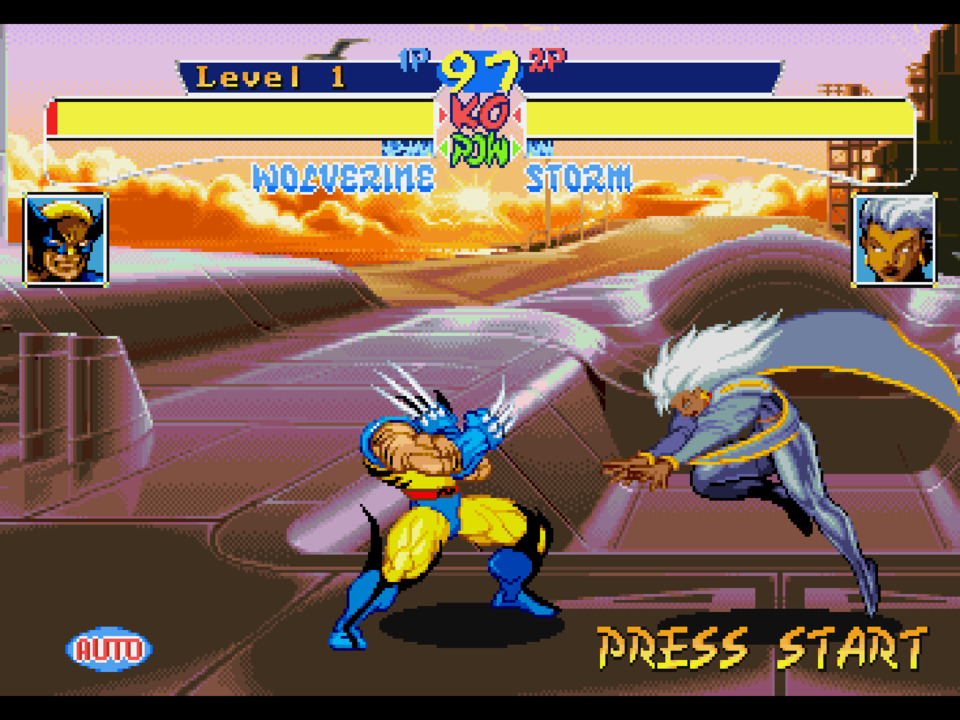
None of that is getting into the weird and wild release schedule of the various home ports for these games, all of which we've seen before at some point, and completely out of order, in this blog series; it seems appropriate that we're seeing the middle game in this line-up last. All this being said, how is the actual game in its own right? It's alright. These Capcom Fighters are fundamentally good. Not just in the controls and mechanics, but in terms of visual artistry, music, sound design, and overall personality they were unrivaled in their genre until Arc System Works got in on the action. Speaking of Arc, If the experience in X-Men stands out from its peers in any way, it would be in the frenetic feel of the matches and density of nonsense happening onscreen. From my limited time, the flow of the fights feels just slightly over the edge of readability and into incoherence. I'm not able to put it into better words, but it feels like a predecessor to the later Anime Fighter sub-genre, and since it was made four years prior to Guilty Gear I can make that kind of statement without getting into trouble. This is also burying the lede on its other, more direct impact. While Alpha and Darkstalkers would go on to have their own series, X-Men is going to lead into Marvel Super Heroes, X-Men vs. Capcom, and then the whole Versus meta-series of Fighting games.
I've spent this much space on background info because I didn't make it very far into the game itself. It has all of the features we've come to expect from CP System II ports, with the only notable addition being a group battle mode where two players pick five characters each and have a kind of competitive ladder fight. That's a neat idea and it’s easy to imagine turning that into the 3v3 system we know from the Versus games.
Then there's the subject matter. I would say that I know a moderate amount about marvel comics stuff, though the 90's tended to produce characters and storylines best left in the past. That's why the roster in this game would seem weird to modern players. Let's take a look. We've got Wolverine, Storm, Cyclops, Iceman, Colossus, Psylocke, Omega Read, Spiral, Silver Samurai, and a Sentinel as playables with Juggernaut and Magneto acting as bosses. Now, those first three are original crew x-people and make perfect sense. The next two seem like kinda second tier x-men but it isn't weird to include them. Psylocke seems like an odd choice; I know she has enthusiasts in the readership but that character has never really broken mainstream. Then we get to the playable villains. I know who Silver Samurai is, though he doesn't seem like an A-tier x-men villain, and I guess it makes sense to put a sentinel in there even if it is generic. Omega Red's inclusion is hilarious and works as well as carbon dating to pinpoint when this thing was made. Then there's Spiral. I had no clue who that was, so I looked her up. Remember when I said the 90's were best left in the past?
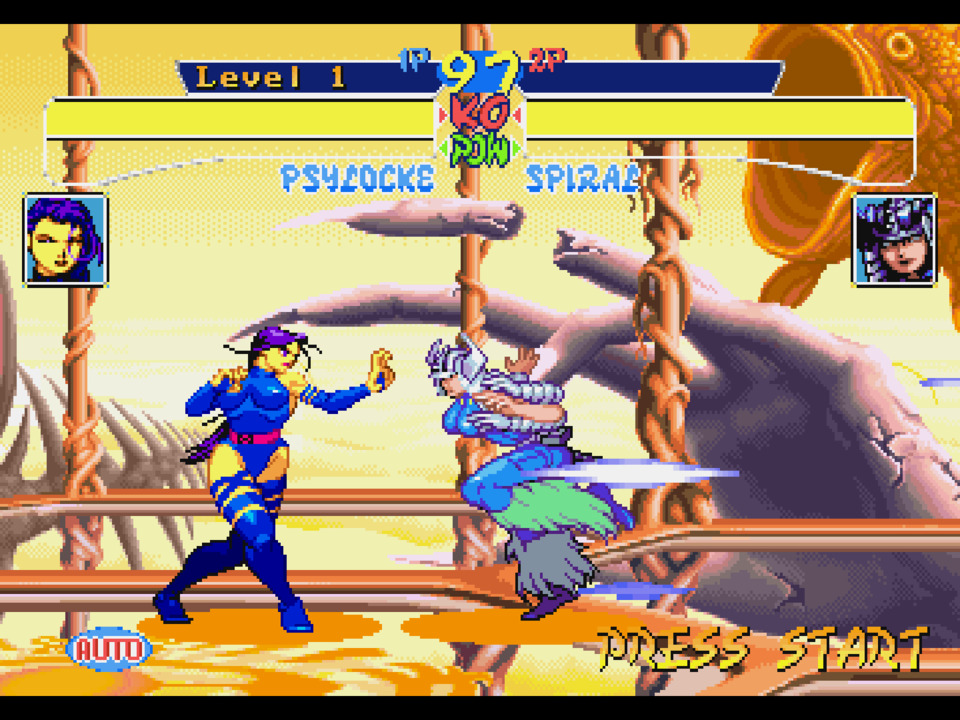
About half of these characters and the bosses seem to be included because of their roles in a comic storyline that ran in the back half of 1993, and I imagine the licensing discussions would have taken place shortly afterwards. For the rest: the comics seem to have recently come off a sentinel centric storyline from a few years prior, Silver Samurai was probably the most prominent Japanese mutant at the time, and Marvel was pushing Omega Red as a Very Important Character™ every chance they got. Then there's Psylocke and Spiral. I looked up what the reason could have been for those two, and I wish I didn't. Turns out Psylocke was originally Captain Britain's sister who could pull out a cool laser knife. In 1989 there was a bizarre storyline where she gets kidnapped by ninjas, brainwashed, and physically altered to look like a Japanese woman. That's problematic, and I personally think DC handled it better when they turned Dr. Light into a Japanese woman…don't ask. Anyway, in '93 some writer at Marvel came around and tried to fix that obviously iffy character development by retconning it as a body swap between the original Psylocke and some Japanese ninja assassin lady, with both ending up back in their original bodies…kinda, I think. The upshot is that this was the other major X-Men storyline going on in late '93, and that's why Psylocke is here. Oh, and Spiral was a minor villain in that arc so she's here to give Psylocke someone to fight, I guess. This probably wasn't the best way to fill out the roster. If they had just taken the main cast of the recent animated show, it might have done better in North America. Regardless, I learned more than I wanted from this game and now so have you.
----------------------------------------------------------------------------------------------------
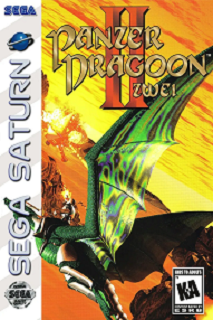
Panzer Dragoon II Zwei
Developer: Team Andromeda
Publisher: Sega
Release Date: 4/17/1996
Time to Crashing The Game: 97 Minutes
I'm going to jump straight to the conclusion just to get it out of the way, Panzer Dragoon II Zwei is the best game that I have yet played for the Saturn. Being an improvement over its predecessor, which was the previous best game on the system, this is the crowning achievement of Team Andromeda's doomed effort to single-handedly drag the Saturn into relevancy. Some would say that the next Panzer Dragoon game, Saga, would be their pinnacle, but as we will eventually see, that game was too little and too late. Instead, we're left with Zwei, easily the best Rail Shooter of that genre's heyday.
Describing the game is a relatively straightforward matter. Zwei reuses the game engine, structure, and basic gameplay loop of the original. This consists of seven levels, called Episodes in the game, where you play as a guy riding around on a young dragon that generally knows where it's going. There's some freedom to move the dragon around the screen in a few sections, but for the most part you're relegated standing in place and shooting everything that moves. To do that you use either a semi-auto free aiming laser gun or the series standard lock-on shots. This is supplemented with a meter-defined super ability which acts as a screen clearing move. This also describes the first one's gameplay, but here there's the added benefit of improved camera turns and a minimap. The big gimmick are the on-foot sections, where the dragon will run around on the ground for certain parts of an Episode. While the shooting works the same, the mobility and dodge opportunities are hampered, giving a greater emphasis on shooting enemies before they can hit you. Without using continues, a playthrough takes around 30-40 minutes.
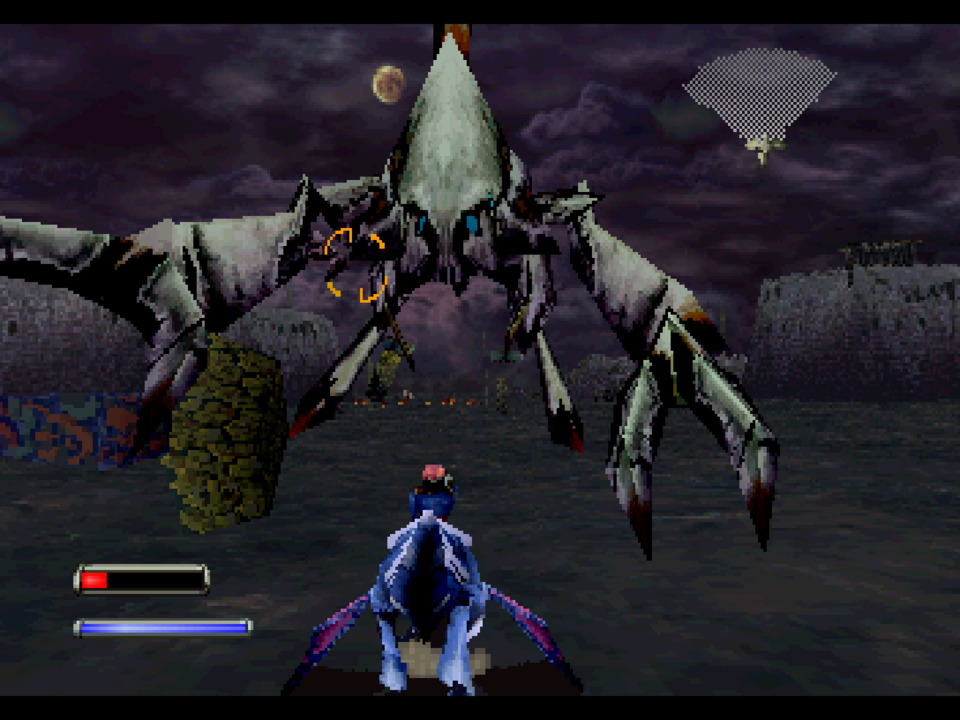
If that sounds basic and dull, know that the encounter and boss design and better thought-out than any other game in the genre and the difficulty settings are precisely dialed in. Even still, the gameplay serves as something to do while experiencing the artistic and technical showcase infused into every section of every episode. That same sentence could also apply to the first Panzer Dragoon, but the swings taken here are bigger and go further, as you would hope from a sequel. The overall plot is still based on enigmatic vibes more than anything else, though there is more narration than before and a coherent throughline to hold the structure together. This relies on voiceover from the player character, a rustic boy who sheltered and raised a mutated herd animal which grows into the aforementioned dragon. In essence, a mysterious ancient airship destroys the boy's village for unknown reasons, and he chases it seeking revenge while contending with the forces of some evil empire that is also out for that airship. In the end, he and his dragon blow everything up before said dragon leaves him behind with a prophetic vision of the events from the first game. So, this is a prequel origin story for the dragon, who I guess is the actual series protagonist.
That limited story and its hints at worldbuilding through the fake language and captivating visual design are mysterious enough to be intriguing, but still don't leave much to latch onto in its own right. What you're here for is the audio/visual experience of it all. The visuals are not only improved from the previous entry but would have been the best available for 32-bit consoles at the time. This is the most graphically stable Saturn title I have yet seen, with enough polygonal density and a long enough rendering distance to pull off the grand set pieces demanded by the visual design. Everything looks otherworldly and alien, while also being explicable in functionality. A lot of mileage is gotten from the juxtaposition of various visual styles present here. You have the tribal aesthetic of the player character and his home village, the vaguely disconcerting creature designs, the technological sophistication of the unknowable ancient devices, and the aquiline, post-steampunk nature of the imperial forces all kind of mashed together in a way that shouldn't work as well as it does.
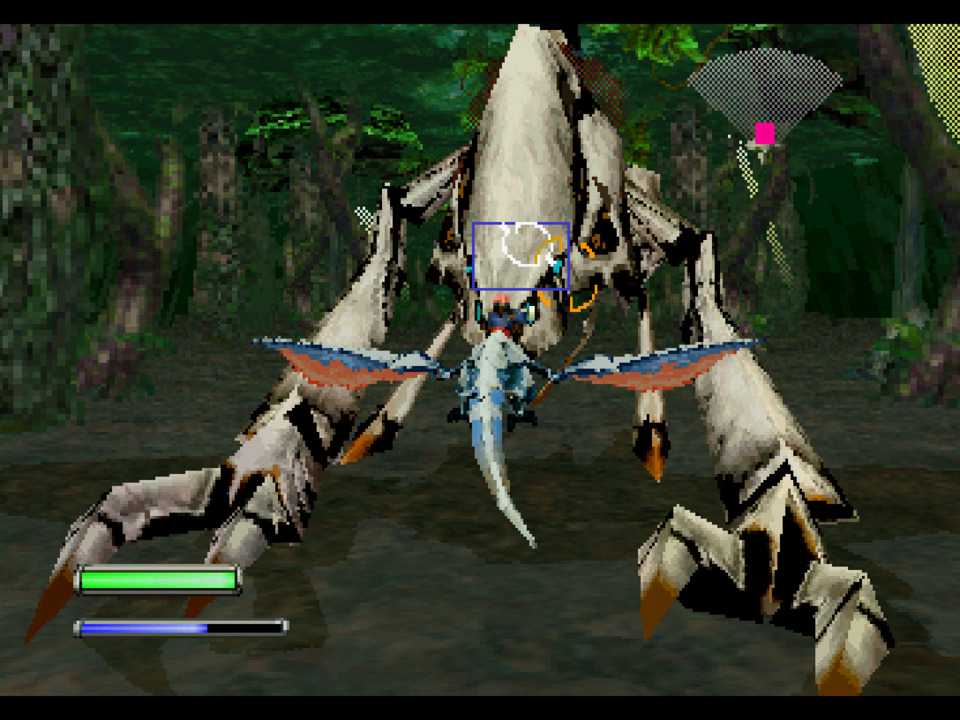
That otherworldly feeling is bolstered by the audio design. While the sound effects are entirely serviceable, the soundtrack is what does the heavy lifting. Even though Zwei lacks the orchestral arrangements of the first game, the composer, Yayoi Wachi, makes use of the Saturn's sound chip in ways that could have been matched by only a handful of contemporary video game composers. I have a difficult time trying to ascribe a musical style to this soundtrack; the closest I get is that it at times evokes some of the later and more esoteric Shin Megami Tensei games. I personally consider that a complement. Of special note for me is the track in the first half of the second episode, The Great Ravine, which you can listen to below, though I would recommend listening to overall OST.
That combination of tight design with audio and visual creative mastery leads to some of the most impressive set pieces I have yet seen from this console generation. Of special note are the first major boss fight and the environment of the sixtth episode. That first boss fight is against an airship, which is on the surface a callback to the first boss in the original game. This time, however, the dragon is running along the ground while the airship flies along all four sides. Most of the pieces of the boss are destructible and will fall off after taking enough damage, including weapons and cargo containers, so I guess this is a heavily armed cargo ship of some kind. As pieces fall off, they will bounce along the ground and potentially hit you, so they will need to be shot or avoided. The amount of stuff that can semi-dynamically bounce around while the airship smokes overhead create an epic feeling spectacle that would have been ahead of its time.
The sixth episode has the player flying along, through, around, and under the antagonistic ancient airship blowing up various parts while dealing with its defenses. The sense of size and physical consistency of the level is complemented by the overall design of the ship and the open sky floored by a far-off sea of clouds. The ship appears on the outside to be bleached white from centuries left out in the sun while also being obviously more advanced than anything else seen in the game, with the interior looking like the dilapidated ruins flown through in the fourth episode. The way it all looks and sounds, combined with the immediate danger of the combat creates a strange, ethereal mood hard to find in console games of the 90's.
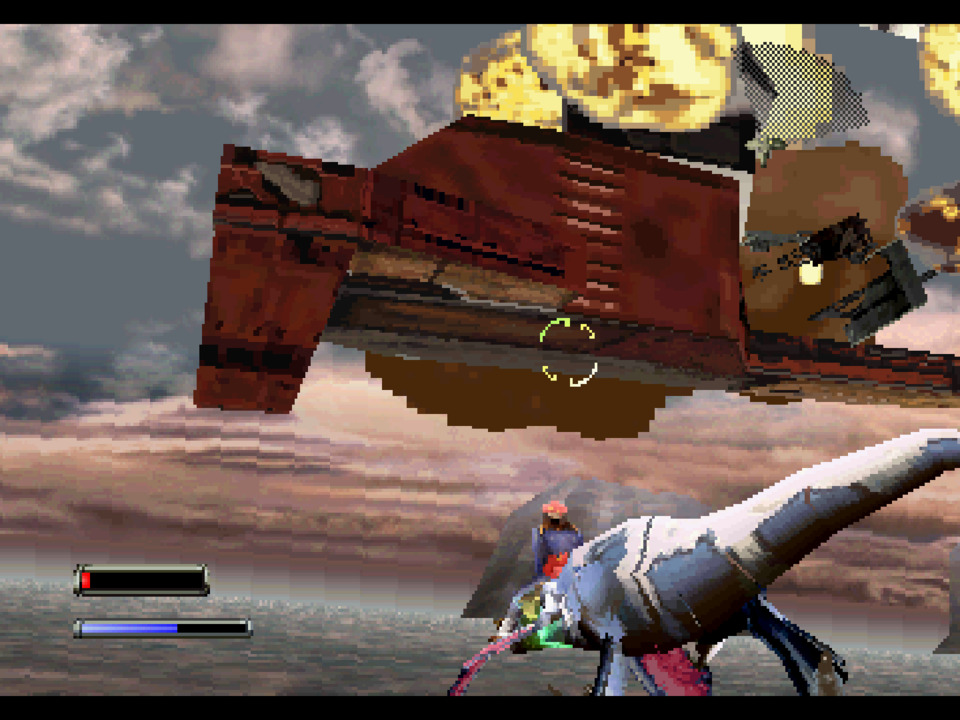
I'm not accustomed to giving out effusive praise, but I feel the need to eulogize Zwei as I would one tragically cut down in the prime of life. See, the Panzer Dragoon series never sold particularly well. The sales data is sketchy/non-existent, but my best guesstimate has these first two games selling well under 1 million units worldwide. We all know how things went for Saga and Orta doesn't seem to have even breached 300k. Funny part is that all four games reviewed well. If this was some middle budget series from a B-tier developer, those number would have been plenty sustainable. Sadly, these games wound up in the unlikely position as the flagship IP for the Saturn. They probably weren't supposed to be, which would explain Sega's late movements to do anything with this franchise. I mean, Bug! was intended to be the next big thing right up until they realized that game was dogshit. The Clockwork Knight games were too old-school in their sensibilities for consumers to care about and, as we will soon see, Nights into Dreams wasn't going to be the new Sonic. Sega stumbled upon the coolest new series of the mid 90's and completely whiffed at using it.
Panzer Dragoon II Zwei might end up being the best, or near-best, game on the Saturn, but it's also the most emblematic example of how Sega destroyed their own console business in the 90's.
----------------------------------------------------------------------------------------------------
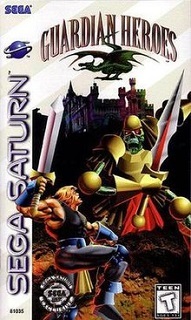
Guardian Heroes
Developer: Treasure
Publisher: Sega
Release Date: 4/24/1996
Time to Doing The Spirits' Bidding: 65 Minutes
While we're on the subject of critically acclaimed flops, let's talk about Treasure. Or that would be what I would say if I was in any way equipped to talk about them. Turns out I know basically nothing about them, and I have no attachment to their games. I've heard of Gunstar Heroes, Mischief Makers, and Radient Silvergun but other than maybe 10 minutes of messing around with Ikaruga twenty years ago I can't say that I've ever played their games. I know they tended to review well and are fondly remembered as masters of the 2D action genre, but I don't have a clear understanding as to why. So, lacking context, let's look at Guardian Heroes on its own merits.
At its most basic, this game is a 2.5D side-scrolling Beat 'Em Up in the classic style. You have a sprite-based character that you walk back and forth along a stage that is three lanes deep. You can jump between those lanes using the shoulder buttons, and usually you can only attack enemies in your lane. You have a standard character selection, with each offering a different balance for combat. That's not too helpful playing alone, but can probably get interesting in coop. That combat works off of a two-button melee and one button magic system, with limited room for combos and specials. The gameplay works exactly as you expect, no more and no less. All the interesting stuff is around the edges.
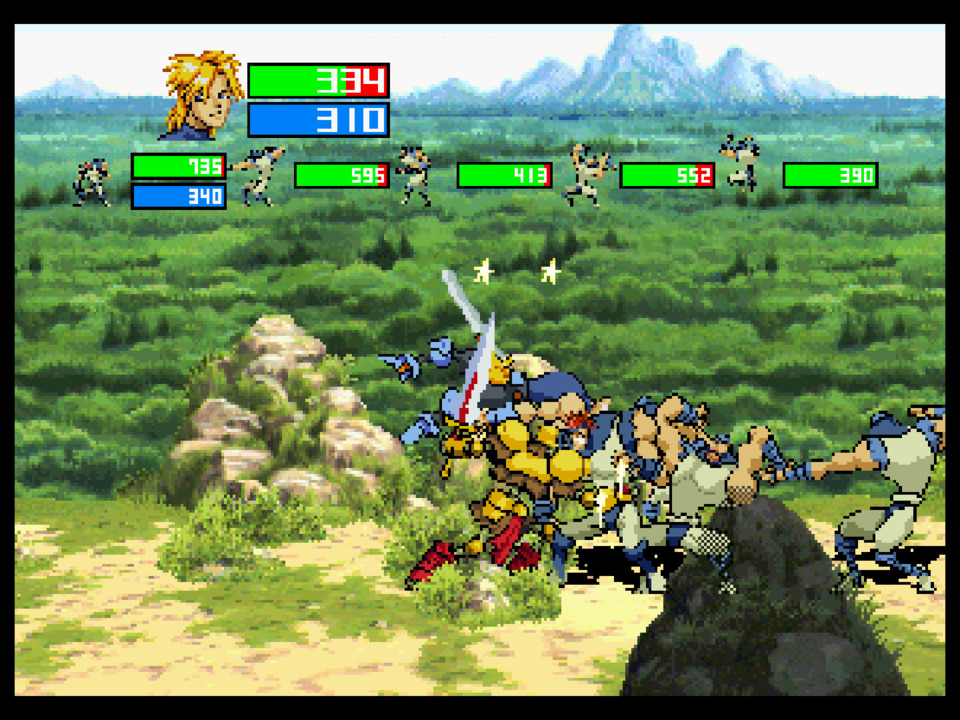
As I hinted above, this is likely meant to be a multiplayer game. It actually reminds me of the much later and likely unrelated Castle Crashers to some extent. The story can be played by, I think, up to four players and there's a kind of proto-Platform Fighter competitive multiplayer mode which supports the six-player controller splitter doohickey that no one bought. That's already relatively full featured for the time, but the story mode has a lot more going on than contemporary arcade Beat 'Em Ups. First, the characters level up between stages, and you can assign basic attribute points. That isn't much but Beat 'Em Ups are generally improved with RPG elements. Second, for most of the game you have an undead knight buddy to whom you can issue basic orders. But most importantly, this thing features multiple branching paths and a simple karma system that work together to create a shocking variety of outcomes in a choose your own adventure kind of way. There are several very different endings and maybe around a dozen ways to get to them. Considering that a playthrough lasts about an hour, players at the time would have been looking at a better content/price ratio than they would have been used to from Action games.
That's not to say the story is any good or well written, however, because of course it isn't. Guardian Heroes has a very basic fantasy JRPG plot with an evil empire, scheming wizards, dethroned royals, and malicious gods that need killing. The only plot element that spices things up a little is the cursed sword which resurrects the undead buddy, though that never really goes anywhere worth going. On top of that, the thing is poorly told through bad, overlong dialogue that went through a, let's say, questionable translation. In fact, the funky English combined with the jokey tone provides a certain camp value which gives the story more charm than it deserves. It balances out somehow to be an ironically positive aspect of the experience.
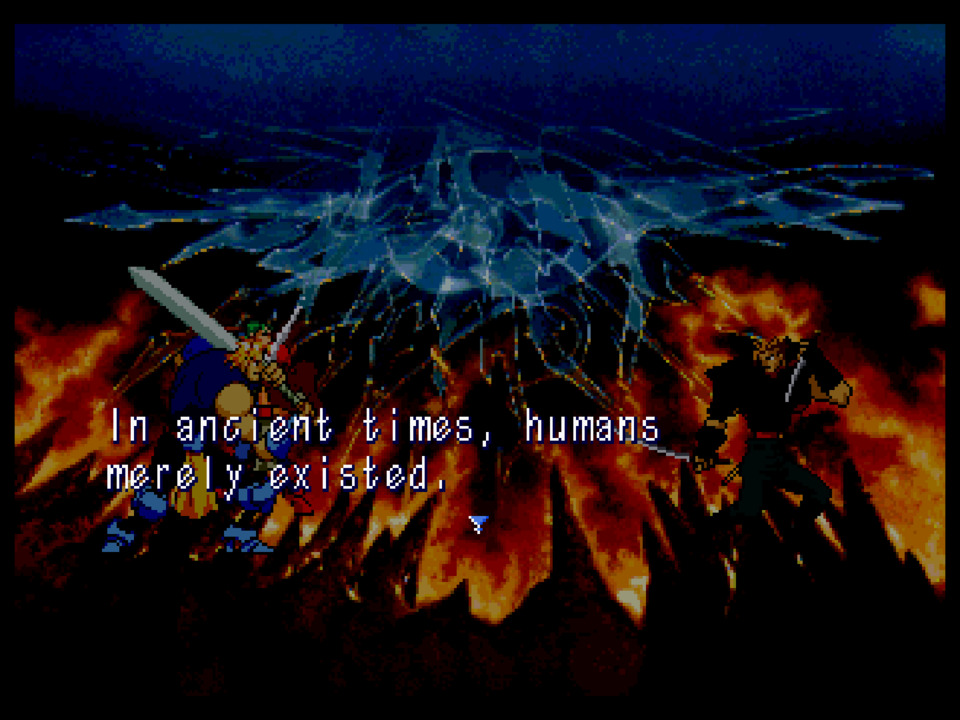
That brings us to the look and feel. The visual design of the various characters evokes butt-tier 90's anime, at least for me. The art style isn't of the same level of quality as something like Astal or any of the Capcom Fighting games, but it's still better than the various attempts we've seen at rotoscoped sprites. Almost despite the questionable aesthetic, the thing animates very well throughout, so again somehow the visuals wrap back around to being good. What is unquestionably the strongest aspect of the experience is the music. I really dig what Treasure was putting down with the audio, and I would say it benefits from not having voice acting that would ruin the vibe. As a reviewer, I'm easily swayed by cheesy vocals and/or random saxophones in game soundtracks. As such, I give the music here 10/10. The least you can do is spend two minutes of your life listening to Shuffler in the Dark through to the end:
The only issue I have is the weird difficulty curve where things become completely unreasonable in the latter part of the game. I'm not sure if there's supposed to be a persistent levelling thing for the characters or what, but I got literally stomped out on what seems like either the second or third to last level after having a very reasonable time up to that point. Still, it's not an insurmountable issue and the totality of the experience is still top notch for the mid 90's. It seems that contemporary reviewers largely agreed with me, though it seems to have sold about as poorly as any other Saturn game. That was enough for it to gain a cult following among Treasure fans (who, again, I do not understand) and it received a release on Xbox Live in 2011 with the online multiplayer you would want from it. I think that version might still work on modern systems, which is neat. I'm not going to recommend every Xbox owner go drop, let's see…five dollars? Huh? Nothing's $5 anymore. Well shit, I guess I do recommend everyone go buy the Xbox version, why not.
----------------------------------------------------------------------------------------------------
This was more of a quality over quantity month for the Saturn, which is a refrain made to make losers feel better about themselves. I might be feeling generous after purging all of that negativity last week, which could explain my sanguine ordering in this week's update to the Ranking of All Saturn Games.
1. Panzer Dragoon II Zwei
…
3. Guardian Heroes
15. X-Men: Children of The Atom
…
72. The Mansion of Hidden Souls
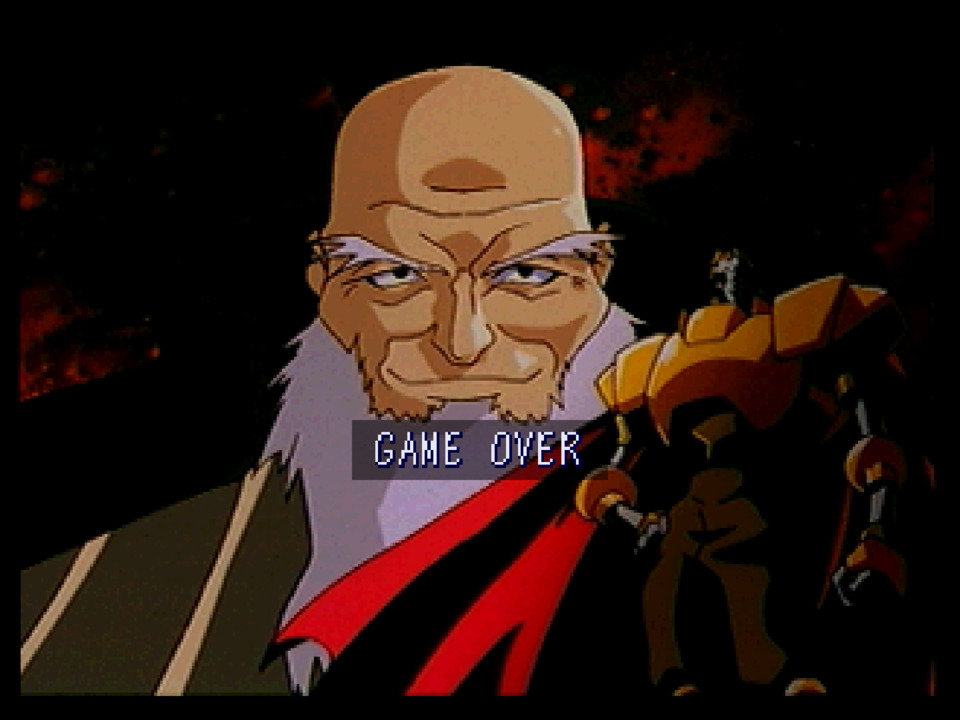
Next week we're going to derail this train yet again as we look at our next batch of 3DO monstrosities classics with Off-World Interceptor, Strahl, Shanghai: Triple-Threat, Starblade, and Advanced Dungeons & Dragons: Slayer.
After that, our derailed train will jump back onto the tracks into a multitrack drift when we look at the May '96 Saturn releases of WipEout, Iron Storm: World Advanced Strategy, Earthworm Jim 2, Slam 'n' Jam '96 Featuring Magic and Kareem, Rise 2: Resurrection, WWF Wrestlemania: The Arcade Game, and Striker '96.
----------------------------------------------------------------------------------------------------
I stream twice a week over on my twitch channel: https://www.twitch.tv/fifthgenerationgaming. We're diving into the depravity of the 3DO and tilting at every possible windmill involving PS1 RPGs.
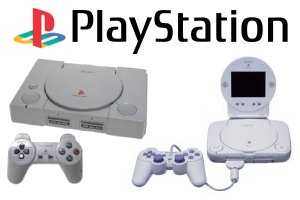
Log in to comment